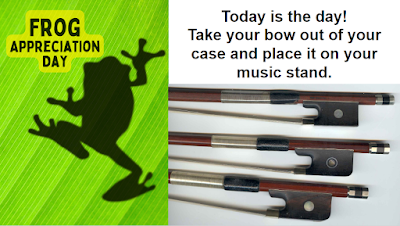Learning how to properly hold a bow is crucial for beginners. It takes time, patience, attention to detail, and good fine motor skills. Students are more likely to focus on the details and work to master bow holds when it is FUN!
Here are a few ways to make learning bow holds fun:
1. Have a 'Frog Appreciation Day.'
My students learn bow holds using straws on the first day of school. Moving up to a real bow is a big deal! You can make it extra exciting by highlighting the day as a celebration. I designed a serious of 'Frog' posters and included them on a google slide presentation that helps teach students some bow basics: parts of the bow, how to care for a bow, bow hold, bow exercises, open string cycle. These slides contain a series of 6 activities students to celebrate 'Frog Appreciation Day.' You can download the presentation HERE ..adjust the wording on the slides to fit your own teaching style. You can use the images on the slides for a fun set of classroom posters.
2. Bow Hold Olympics
String players have much to think about while playing. I've found it very helpful to isolate bow skills by having a 'Bow Hold Olympics' while students are learning to master bow holds. This involves one entire class period practicing only bow skills. I clean up all chairs and stands and students spread out to complete various Olympic events. The open space allows me to freely walk through the group and help students are need to make bow hold adjustments.
You can design you own Olympic bowing events, or use my slides HERE. 8 total event challenges are included with descriptions on each slide - 22 slides total. Some challenges require teams for relay-type events while other events are individual.

.png)











